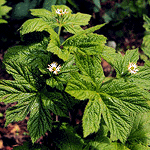|
|
The Eclectic Physician
Medicinal Herb Monographs
Goldenseal
Botanical Name
Hydrastis canadensis
|

Hydrastis canadensis
(Golden Seal)
|
The information on this page compiled by
Beth Burch N.D.
Index
(click on the keywords)
Introduction
Hydrastis has been traditionally used by Native Americans to treat conditions
of the mucous membranes of the respiratory, digestive and urinary tracts
and also disorders of the skin and eyes. Because the root has a bright
yellow color, it was also widely used as a dye.
The Eclectic physicians of the 19th century used Hydrastis extensively,
for a side variety of problems including as an appetite and digestive stimulant,
for mouth sores, chronic gastritis and gastric ulcer, liver and gallbladder
complaints, diarrhea, hemorrhoids, fissured anus, pharyngitis, nasal catarrh,
conjunctivitis, otitis media and externa, muscle soreness, uterine hemorrhage,
acne and eczema. Kingís Dispensatory states it is specifically indicated
in any chronic catarrhal state of the mucous membranes of the respiratory
and digestive systems.
Naturopathic physicians have long used it as a part of Robertís Formula
(also contains echinacea, slippery elm and other herbs) in the treatment
of ulcerative conditions of the digestive tract. The success of Robertís
formula in the treatment of duodenal ulcer may be due to the antimicrobial
effects of berberine in the Hydrastis which may act against Helicobacter
pylori.
Modern studies with berberine show it to be very effective in the treatment
of diarrheal illness, especially those caused by bowel toxin producing
bacteria. Topical use of berberine has also been shown to be effective
in treating eye infections caused by Chlamydia trachomatis.
[ Back to the Index. ]
Description
-
Hydrastis is a member of the Ranunculaceae family, indigenous to the eastern
US and Canada. It prefers undisturbed woodlands. It is a perennial herb
with a knotty, creeping bright yellow root or rhizome. It has two alternate,
palmate, large and lobed leaves with small white flowers. The official
part is the root or rhizome.
[ Back to the Index. ]
Constituents
-
Isoquinoline alkaloids-hydrastine, berberine, canadine, hydrastinine
-
Resins
-
Fatty acids
-
Volatile oils
[ Back to the Index. ]
Action/Effects
-
Berberine-
-
Antibiotic- broad spectrum, antimicrobial against bacteria, protozoa &
fungi (1)
-
Antiinfective- inhibits the adhesion of Streptococci to host cells (1)
-
Immune modulation (7)
-
Cholerectic- stimulates the secretion of bile
-
Tonic & astringent
-
Bitter digestive stimulant
-
Hydrastine-
-
Hemostatic
-
Oxytocic- stimulates the contraction of uterine smooth muscle
[ Back to the Index. ]
Conditions used
for
-
Inflamed mucous membranes with excessive mucous production
-
Gastrointestinal infections with diarrhea (2,3,4)
-
Respiratory tract infections (1,8)
-
Urinary Tract Infections (5)
-
Infections of the eyes (6)
-
Enhances immune function (7)
[ Back to the Index. ]
Dosage
-
Because of goldensealís very bitter taste, many people find encapsulated
or glycerin preparations easiest to take. The exception would be if taking
Hydrastis as bitter digestive stimulant, then it would be preferable to
use the liquid extract form.
-
Dried root- 500mg to 2 grams three times a day
-
Liquid extract- 1/2-1 teaspoon three times a day
-
Glycerin- 1/2-1 teaspoon three times a day
-
Childrenís dosage- Multiply adult dosage times the childís weight, then
divide by 150.
[ Back to the Index. ]
Side Effects
-
Depletes B vitamins- if using Hydrastis in high doses or long term, supplement
B vitamins
-
Possible disruption of normal bowel flora if used long term- supplement
with Lactobacillus
[ Back to the Index. ]
Contraindications
-
Pregnancy
-
Infants with G6PD deficiency
[ Back to the Index. ]
Interactions
with medications
[ Back to the Index. ]
Use in
pregnancy & lactation
-
Should not be used in pregnancy until after 37 weeks due to uterine stimulant
effects.
-
Nursing mothers with infants who have G6PD deficiency should not use Hydrastis
[ Back to the Index. ]
References
1. Sun D et al, Berberine sulfate blocks adherence of Streptococcus
pyogenes to epithelial cells, fibronectin and hexadecane, Antimicrob Agents
Chemother 1988;32(9):1370-4
2. Rabbani GH, Mechanism & treatment of diarrhea due to Vibrio
cholerae and E. coli: roles of drugs and prostaglandins, Dan Med Bull 1996;43(2):173-85
3. Zhang MF et al, Antidiarrheal and anti-inflammatory effects of berberine,
Chung Kuo Yao Li Hsueh Pao 1989;10(2):174-6
4. Rabbani GH et al, Randomized controlled trial of berberine sulfate
therapy for diarrhea due to enterotoxigenic E. coli and Vibrio cholerae,
J Infect Dis 1987;155(5):979-84
5. Sun D et al, Influence of berberine sulfate on synthesis and expression
of Pap fimbrial adhesin in uropathogenic E. coli, Antimicrob Agents Chemother
1988;32(8):1274-7
6. Khosla PK et al, Berberine, a potential drug for trachoma, Rev Int
Trach Pathol Ocul Trop Subtrop Sante Publique 1992;69:147-65
7. Rehman J, et al, Increased production of antigen-specific immunoglobulins
G & M following in vivo treatment with the medicinal plants Echinacea
angustifolia and Hydrastis canadensis, Immunol Lett, 1999;68(2-3):391-5
8. Gentry EJ et al, Antitubercular natural products: berberine from
the roots of commercial Hydrastis canadensis powder, J Nat Prod 1998;61(10):1187-93
[ Back to the Index. ]
* The information presented in this web site is intended to inform and educate.
It is not intended replace a qualified medical practitioner to diagnose or treat medical conditions.
|
|

